How To Install Seo Plugin In Wordpress
Every WordPress site needs an SEO plugin if they want to stand a change of getting their pages to show up in search engine rankings. And when it comes to SEO plugins, Yoast SEO is by far one of the most popular options. WordPress SEO is, unavoidably, a complex topic, though. And to address that, Yoast SEO has built in plenty of complex features to give you pinpoint control over your site's SEO.
As a result, even though the Yoast team has done a great job trying to make SEO beginner-friendly, there's still a good chance you need some help with how to use Yoast SEO. To give you that help, we've written this monster Yoast SEO tutorial.
It's such a big guide that we've split it into two parts:
- The beginner's guide to Yoast SEO – in this section, we'll cover tips for first-time users and casual users. If you're already familiar with Yoast SEO's basic settings and the Yoast SEO meta box, you might find it a little redundant.
- The advanced guide to Yoast SEO – in this section, we'll cover more advanced tactics like title/meta variables, noindex tags, and more. Even if you've already been using Yoast SEO on your site, you can probably get some added value from this section.
Ready to learn how to use Yoast SEO? You can click above to skip straight to the advanced section. Otherwise, let's start at the beginning!
Take a deep dive into how you can use Yoast to boost your WordPress site's SEO. 👍 Click to Tweet
The Beginner's Guide To Yoast SEO
In this section, we'll cover what you need to know if you're new to Yoast SEO. You'll learn:
- How to properly enter information in the configuration wizard
- What the Yoast SEO meta box is and how it works
- What you can do from the Yoast SEO dashboard
Then, in the next section, we'll get into some of the more advanced Yoast SEO settings.
Using The Yoast SEO Configuration Wizard
After installing Yoast SEO, you can access the Yoast SEO dashboard by clicking on the new SEO tab in your WordPress dashboard.
If this is your first time using the plugin, you should see a big notice for First-time SEO configuration.
By clicking the configuration wizard link, Yoast SEO will give you a guided tour to help you set up all of the basic SEO settings:
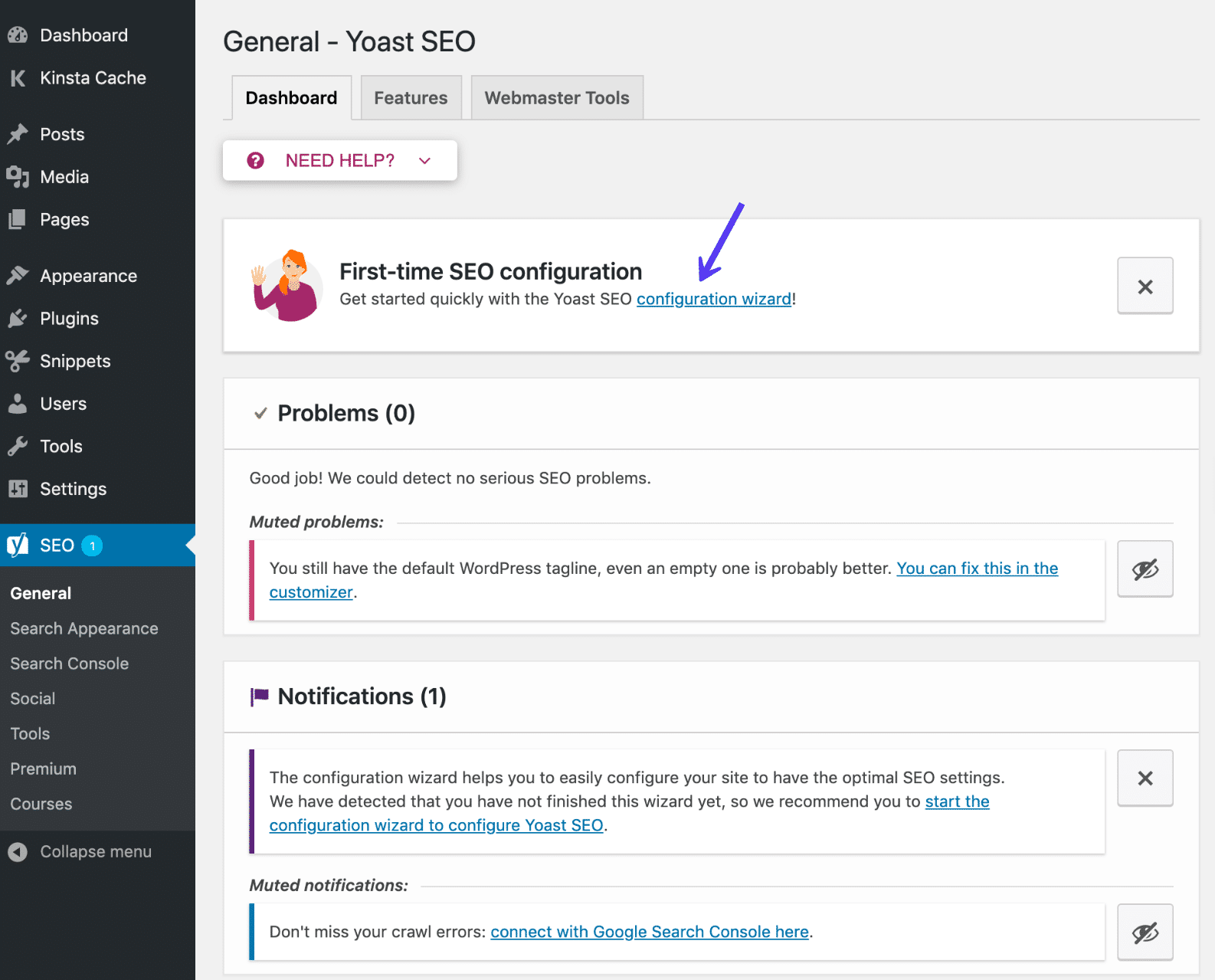
Go ahead and click that link. Then, on the first page of the wizard, click Configure Yoast SEO.
Below, we'll take you through the rest of the sections in the configuration wizard.
Section 1: Environment
In the Environment area, you should always choose Option A unless you're working on a development site:

Section 2: Site type
In the Site type section, try to choose the type of site that best matches your site:
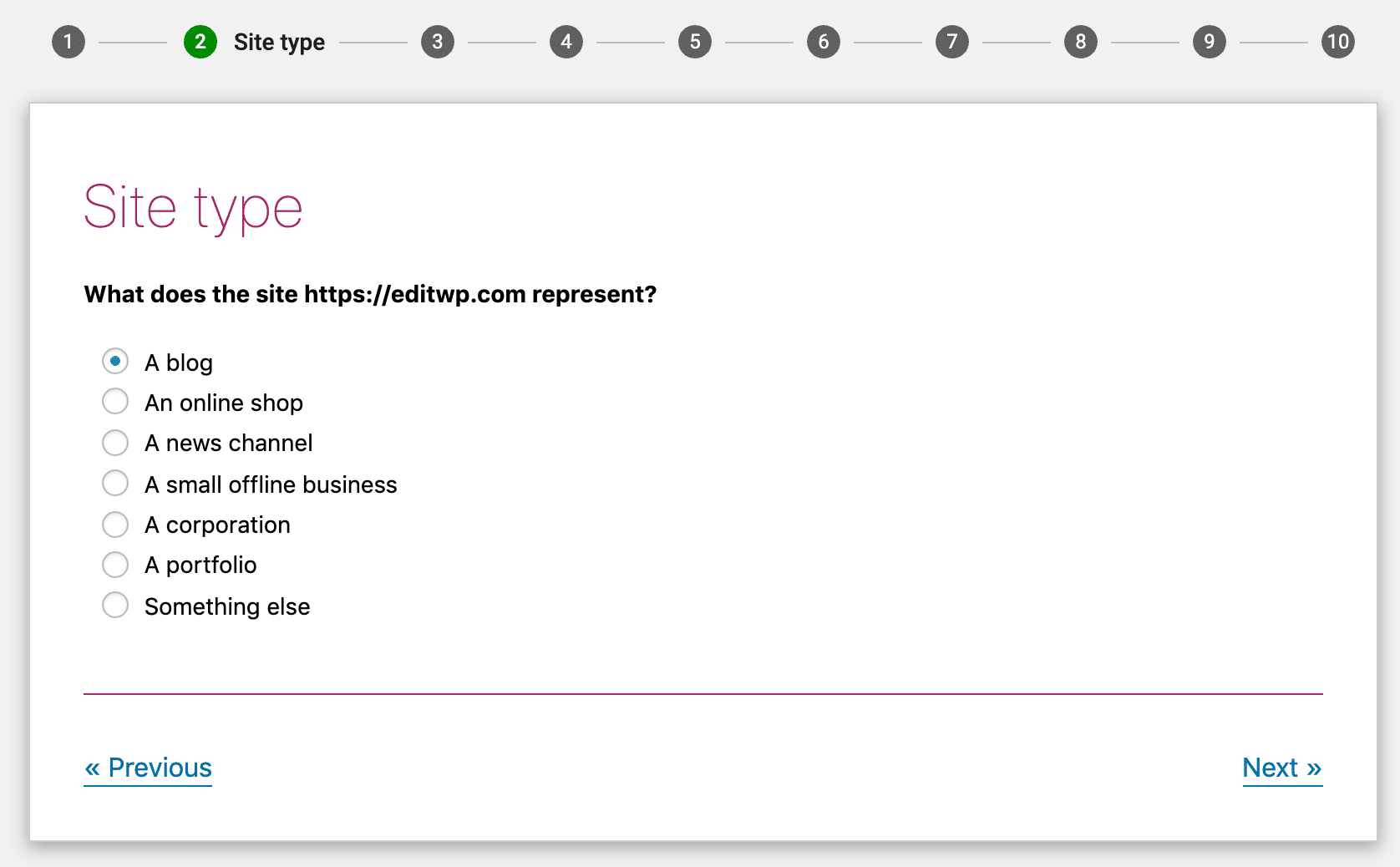
Section 3: Organization or person
Next, choose whether your website represents an organization or a person.
If you choose Organization, you'll be asked to also enter:
- The name of the organization
- Your organization's logo (112x112px, at minimum. We recommend a square logo.)
And if you choose Person, you'll just need to enter the name of the person.
Enter all of the social media profiles for your website. If you're creating a website for an organization, this will be your organization's social media profiles. If it's a person, you can edit the details, like the social profiles, the name and the description of the user on their WordPress profile page.
You don't need to enter all of them – just choose the social media profiles that you actively want to promote:
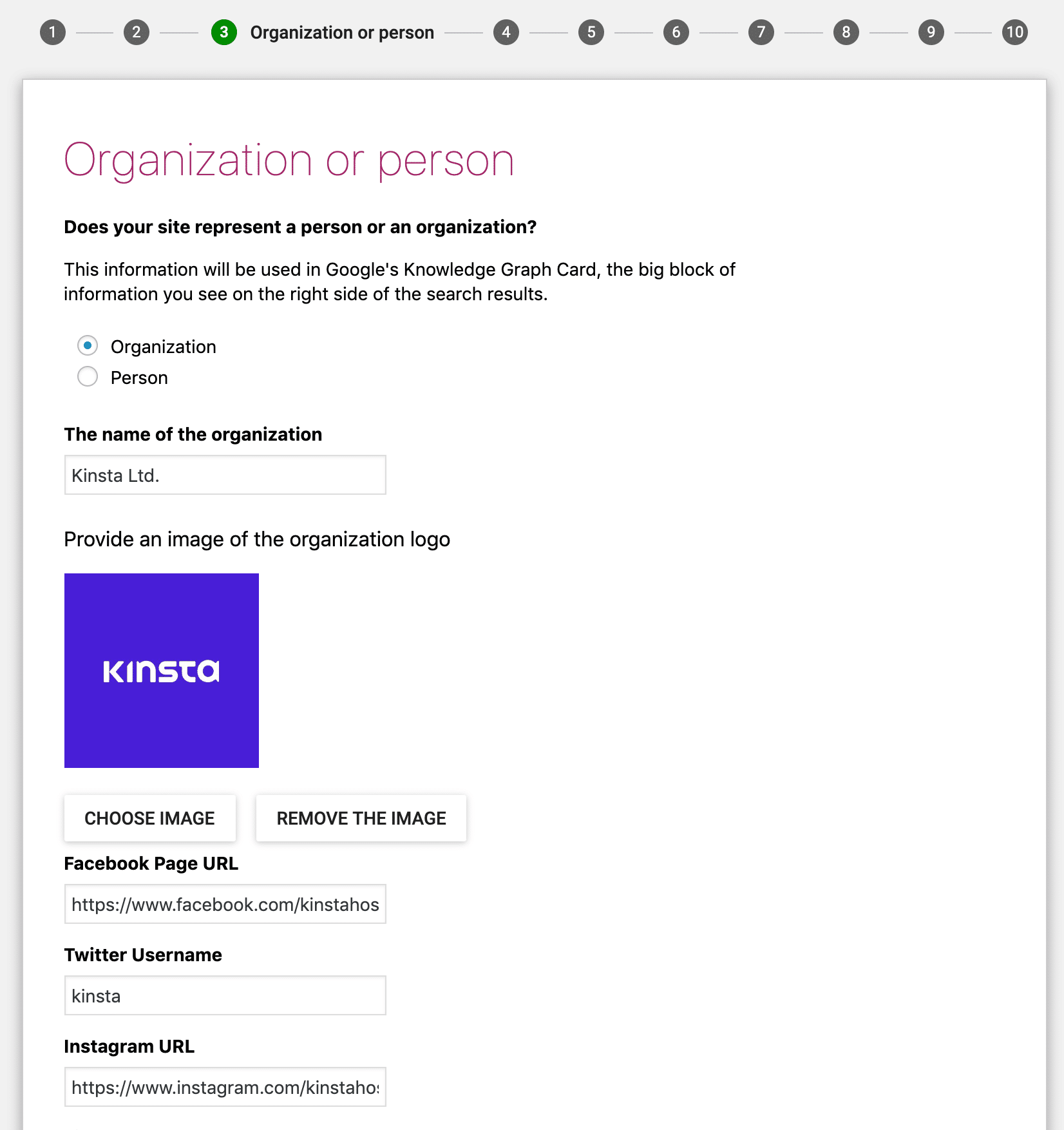
This section helps Yoast SEO provide additional information to Google to generate a Knowledge Graph Card. These cards are pretty eye-catching, so every little bit of information helps:
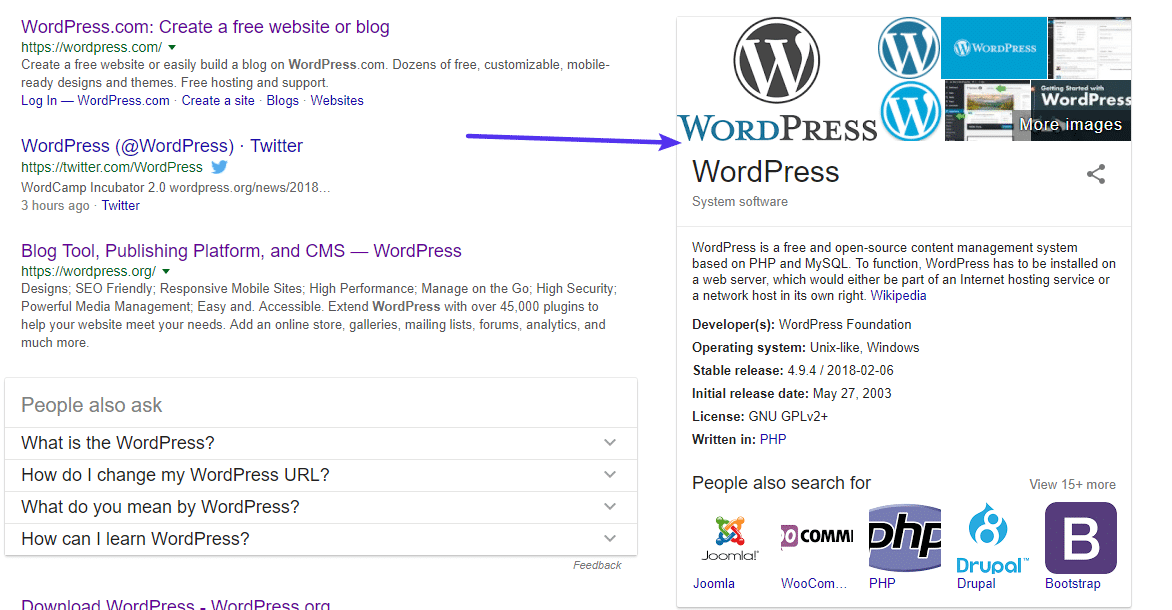
Section 4: Search engine visibility
In the Search engine visibility section, you can choose whether or not to allow certain types of content to be indexed in search engines (Suggested reading: 21 Alternative Search Engines to Use).
99.99% of the time, you want to leave these as the defaults. Unless you already know what you're doing, don't change anything:
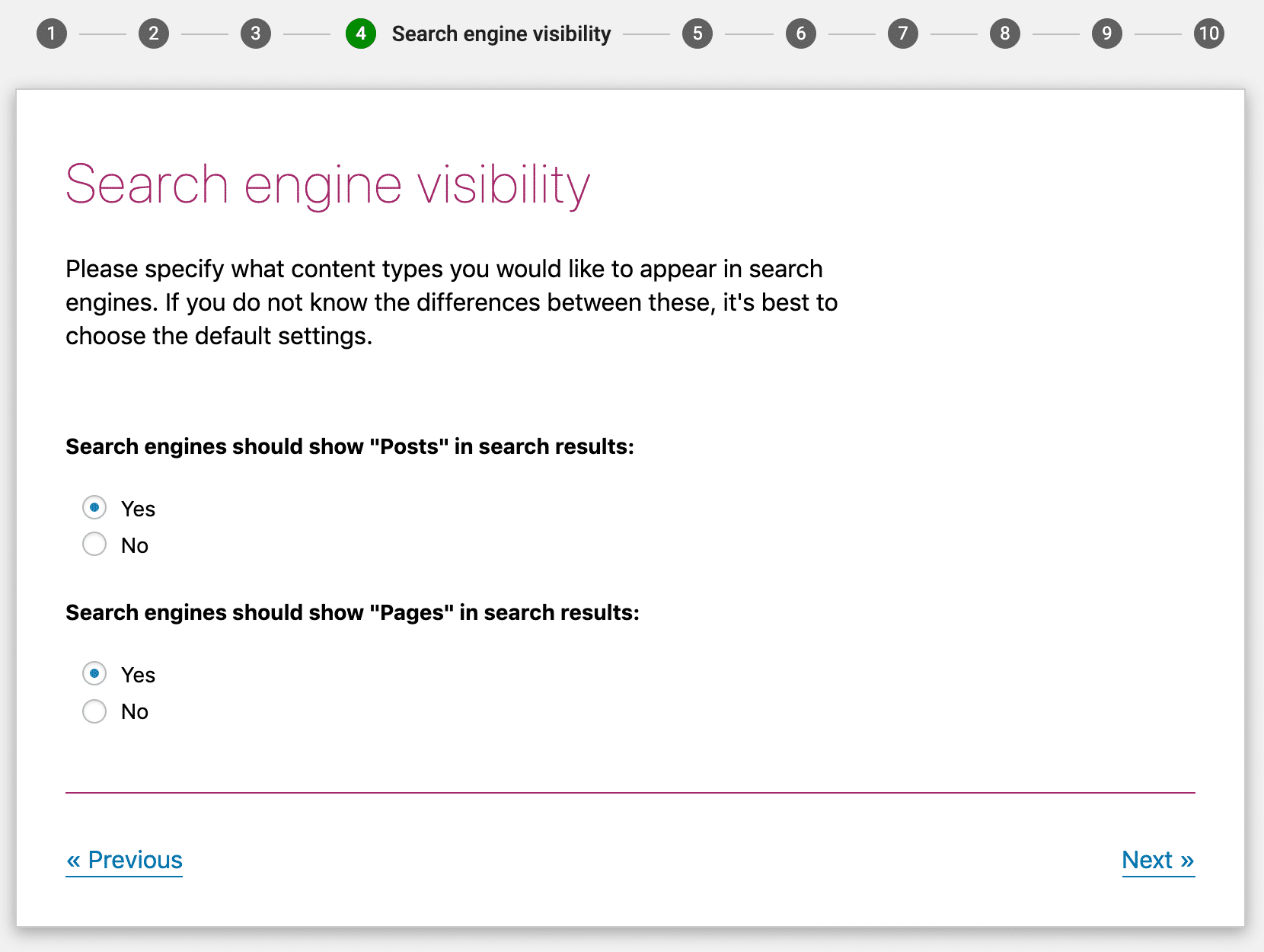
Section 5: Multiple authors
If you're the only person writing on your site, Yoast SEO will automatically mark your author archives as noindex to avoid duplicate content (noindex tells search engines not to index that page).
Yoast SEO does this because, on a single author blog, the author archives are 100% identical to your actual blog index page.
If you do plan to have multiple authors, choose yes so that people can still find a specific author's post archives in the Google search results:

Section 6: Google Search Console
Google Search Console is a tool from Google that allows you to view information about how your site works in Google organic search. If you're already using Google Search Console, you can allow Yoast SEO to import information by clicking the Get Google Authorization Code and entering the code here.
If you're not sure what Google Search Console is, feel free to just click Next and skip this for now. While Google Search Console is definitely something you should investigate eventually, it's not something that's necessary to the functioning of Yoast SEO:
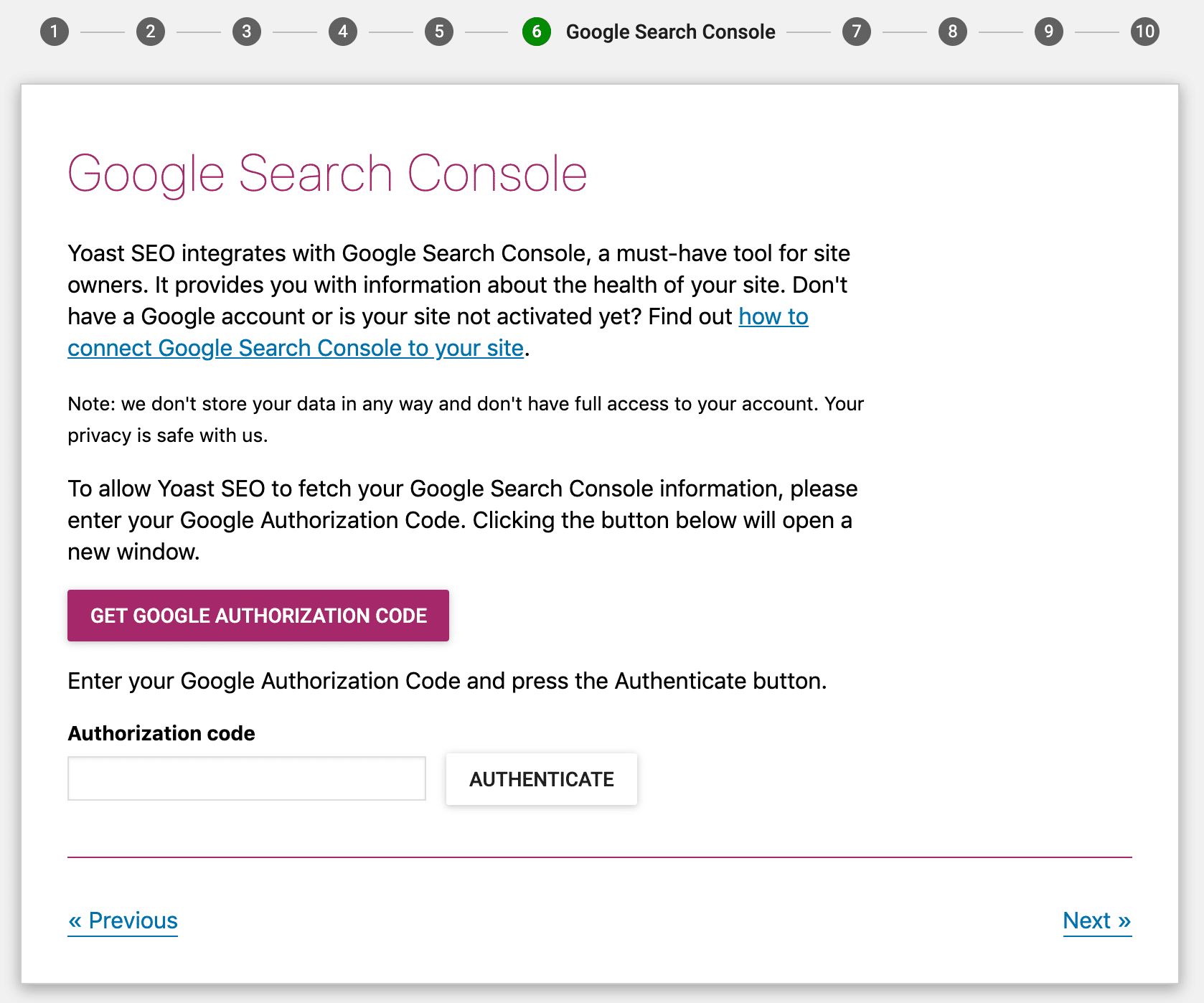
Section 7: Title settings
Your Title is the main headline that appears in Google search results (and visitors' browser tabs):

By default, Yoast SEO makes your title:
Post Name *Separator* Website Name
In this section, you can choose:
- Your website name
- The *Separator*

For example, if you had a post with the title "How To Use Yoast SEO" and the settings above, your site would look like this in Google:
How To Use Yoast SEO - Kinsta Demo Site
Wrapping Up The Configuration Wizard
In sections 8 and 9, Yoast SEO will try to get you to:
- Sign up for the Yoast SEO newsletter
- Purchase Yoast SEO Premium, keyword research training, or plugin training
You do not need to do either of these things unless you want to.
Just keep hitting next until you get to section 10 – Success! And then click Close:

Congratulations – you just configured Yoast SEO!
Using The Yoast SEO Meta Box
On a day-to-day basis, the Yoast SEO meta box is where you'll interact with the plugin the most. The meta box helps you by:
- Analyzing your content for its SEO quality and readability
- Letting you configure settings for how your content functions in Google and social media
The meta box appears underneath the WordPress editor (its exact location depends on your other plugins and themes). If you're using the new WordPress block editor, you can find this on the right-hand sidebar as well. There are three different ways to interact with the meta box:
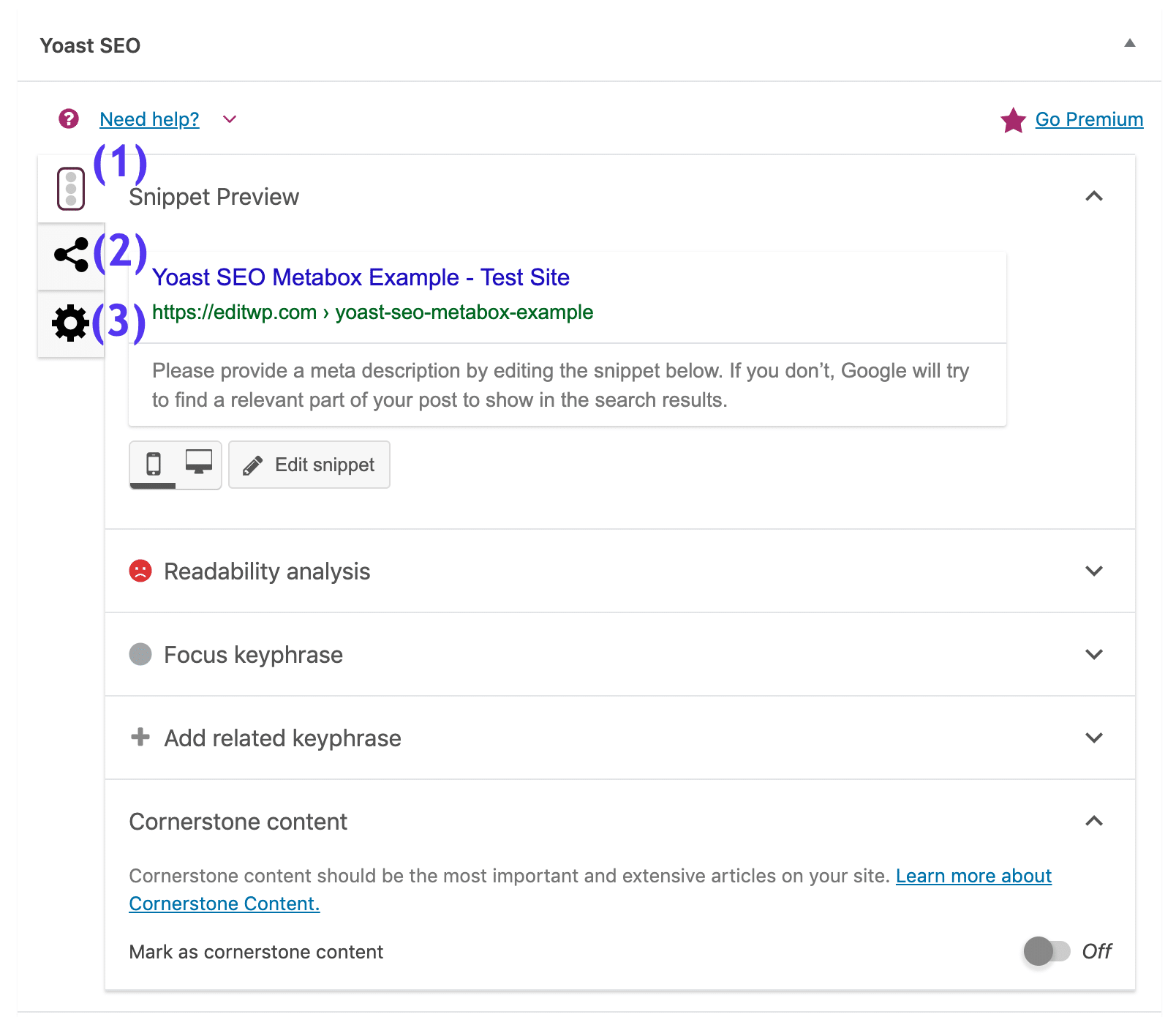
- (1) – lets you switch between Snippet Preview, Readability analysis, Focus keyphrase, and Cornerstone content
- (2) – lets you access additional settings for social media
- (3) – lets you access advanced options
Content Optimization Tab
The Content Optimization tab is mostly about how well optimized your content is for search engines.
The first area in the content optimization tab is the Snippet preview.
You can click the Edit snippet button to manually edit your content's SEO Title and Meta description. You'll see a live preview at the top as you edit the information:
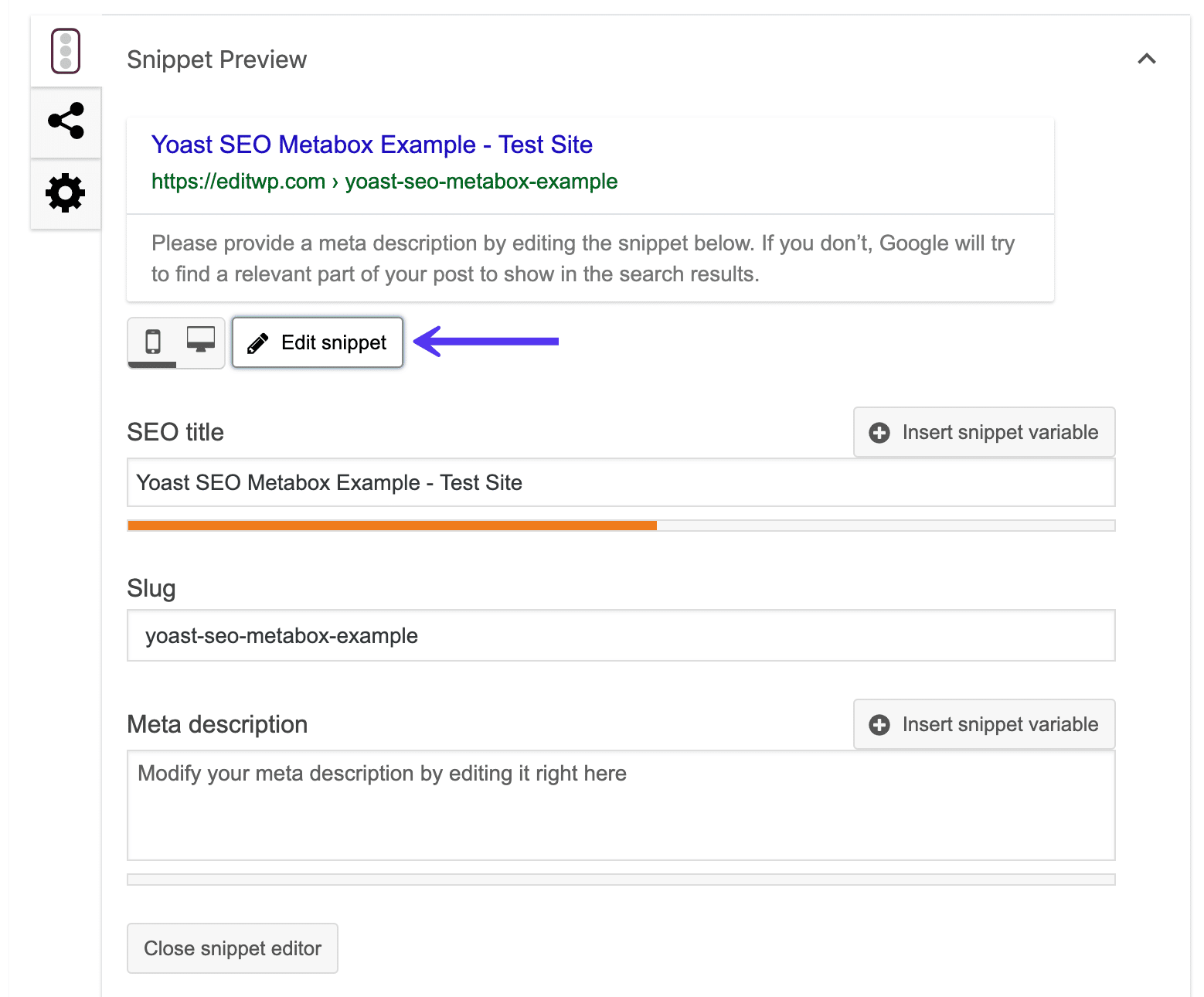
This information is important because it's what will show up in Google's organic search results:

In the Readability analysis area, Yoast SEO tries to apply that same concept to humans. Essentially, it tries to gauge how readable your content will be to human visitors and then makes some suggestions for how to improve your content's readability.
These suggestions aren't perfect – so don't feel like you need to get a perfect score. But they are a good high-level guide:
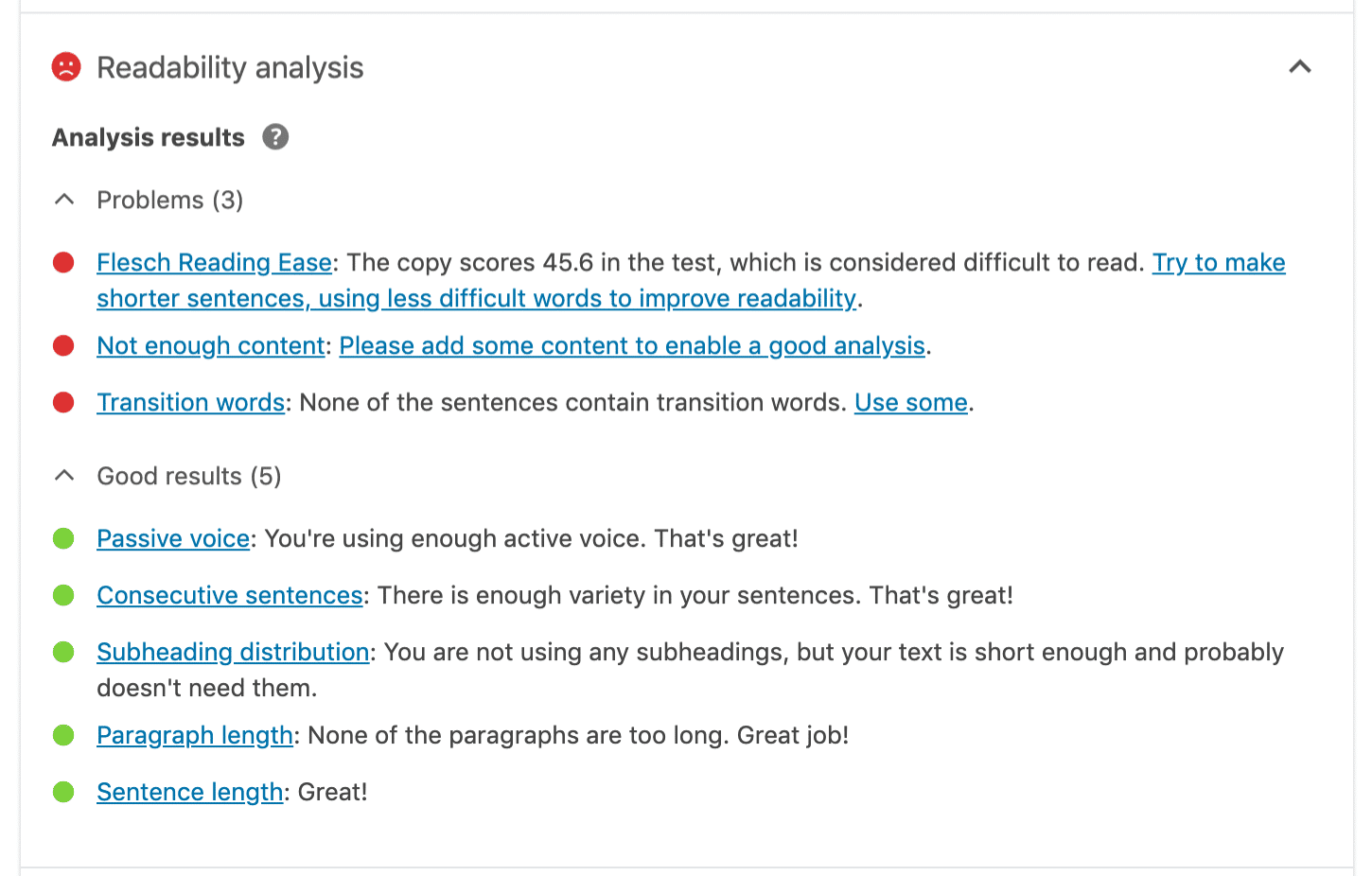
In the Focus keyphrase area, you can enter a Focus keyword to optimize your content for.
Essentially, you'll want to perform some basic keyword research to find a keyword that people are searching for. Then, you plug that keyword into this box and Yoast SEO will analyze your content to see how well optimized your post is for that specific keyword.
It will tell you both what you're doing well and what needs to be improved. If you are using the premium version of Yoast SEO you can also add a related keyword.

It's important to remember that the Yoast focus keyphrase doesn't help you rank in Google. It's only advice to help you optimize your content.
In the Cornerstone content area, you can choose whether or not to designate the post as cornerstone content.
Cornerstone content is the core of your website. It consists of the best, most important articles on your site; the pages or posts you want to rank highest in the search engines. Cornerstone articles are usually relatively long, informative articles, combining insights from different blog posts and covering everything that's important about a certain topic.

In other words, only choose your best content and posts or pages that you are going to keep up to date as cornerstone content. You can then easily sort by your cornerstone content in the posts and page lists.
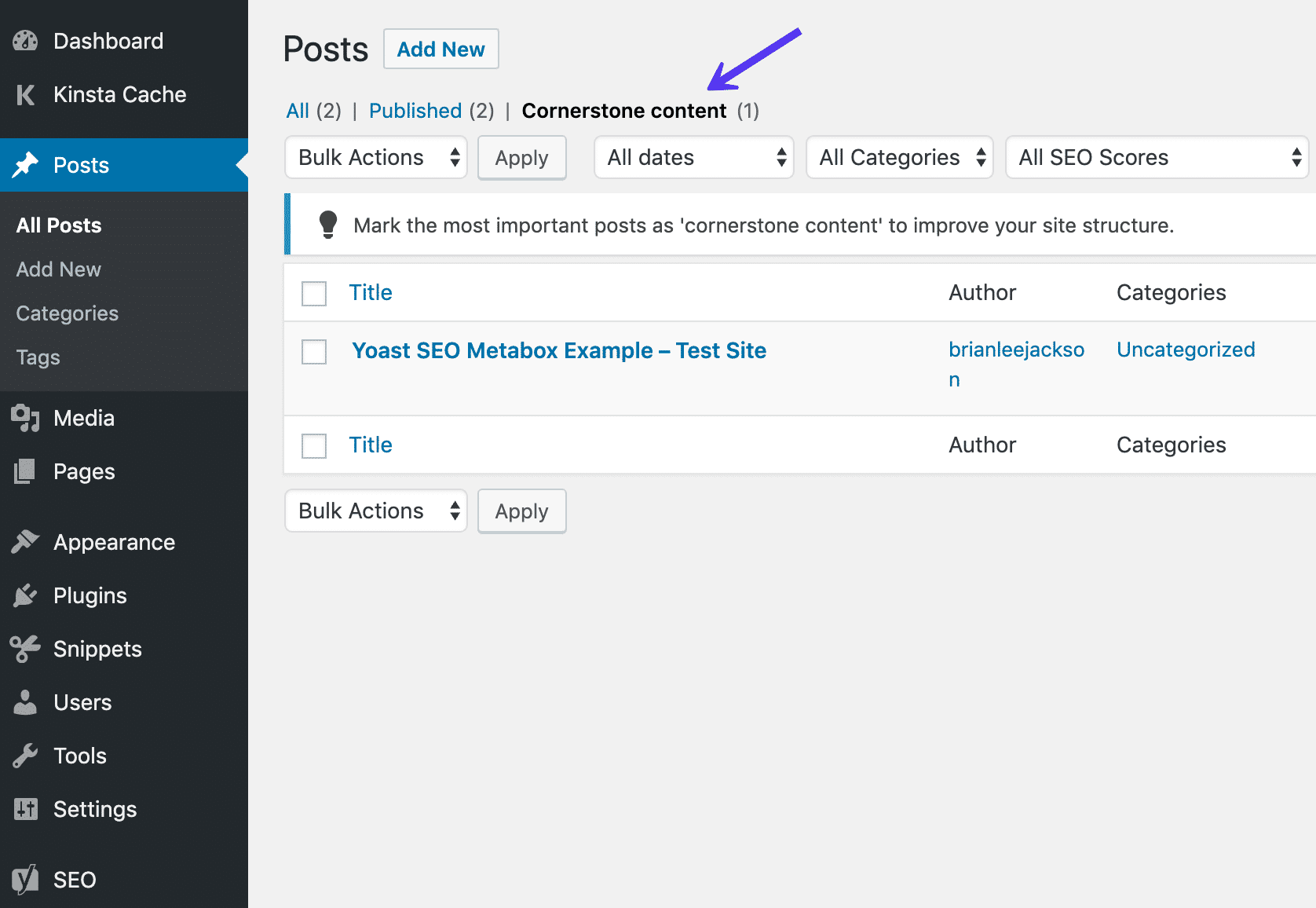
Yoast SEO Social Media Tab
In the Social tab, you can manually configure how your content will look when shared on Facebook or Twitter:
Want to know how we increased our traffic over 1000%?
Join 20,000+ others who get our weekly newsletter with insider WordPress tips!
Subscribe Now
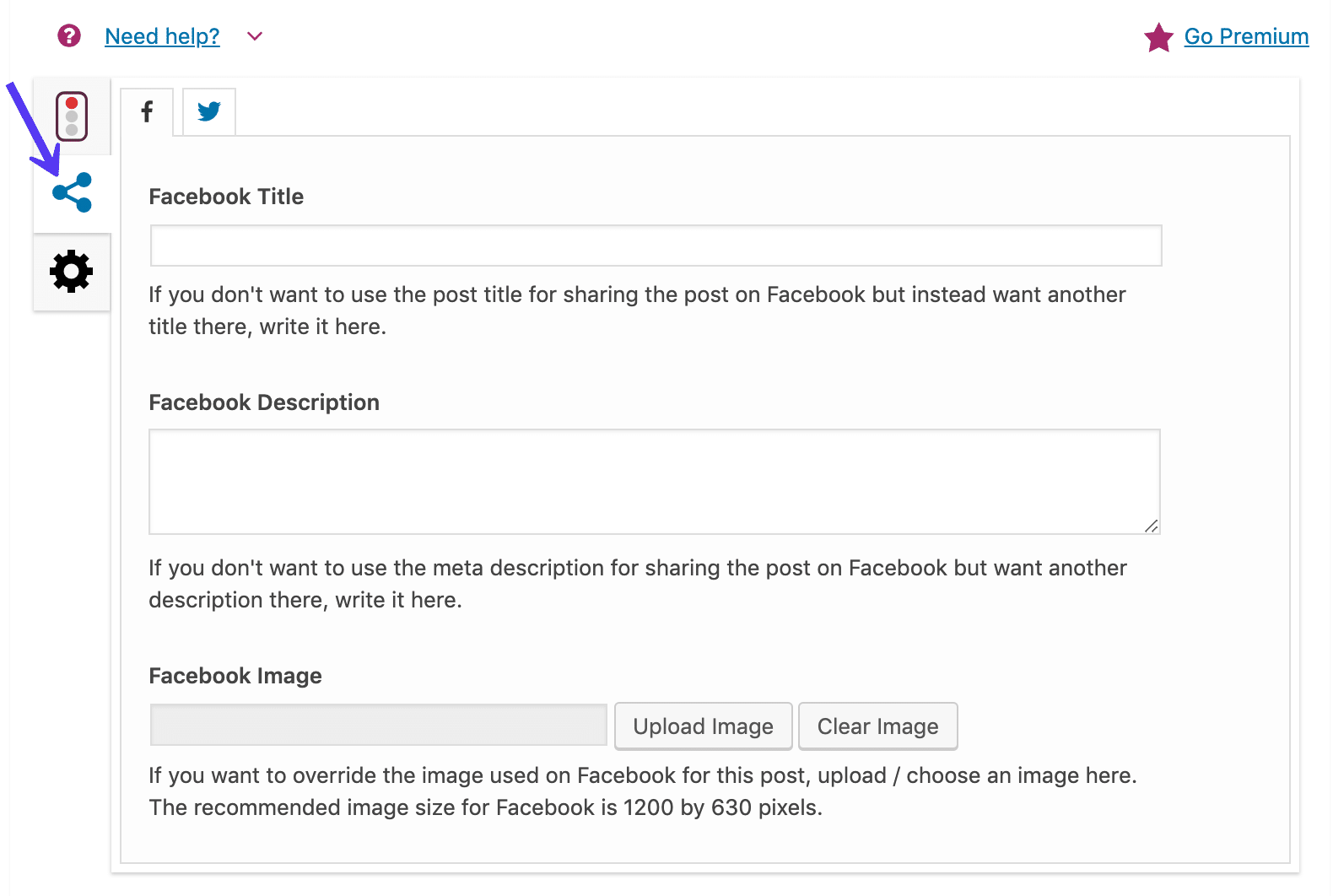
This is the information that a social network automatically generates when a URL is shared:
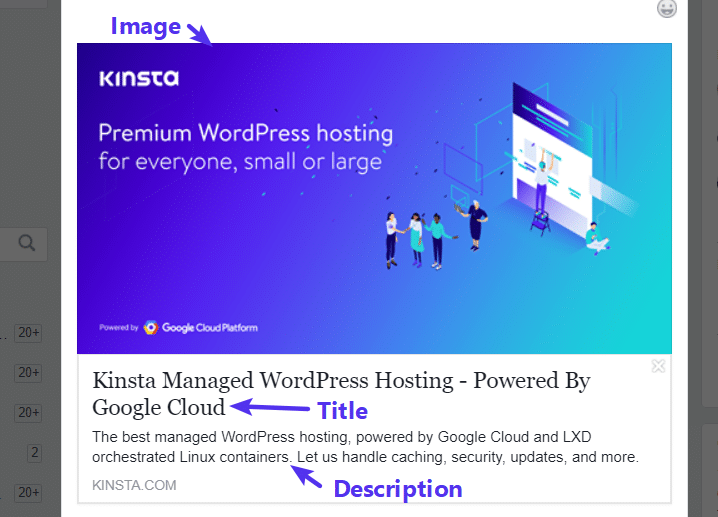
Most of the time, you don't need to manually configure this information for each post because Yoast SEO will automatically generate it based on:
- Your SEO title
- Your content's featured image
But if you want to override those defaults, this is where you do it.
Yoast SEO Advanced Tab
Most of the time, you won't ever look at the Advanced tab. But if you want to:
- Stop Google from indexing this specific piece of content. Or in other words, allow or disallow search engines from showing it in search results.
- Specify a canonical URL to avoid duplicate content.
Then this is where you can do it:
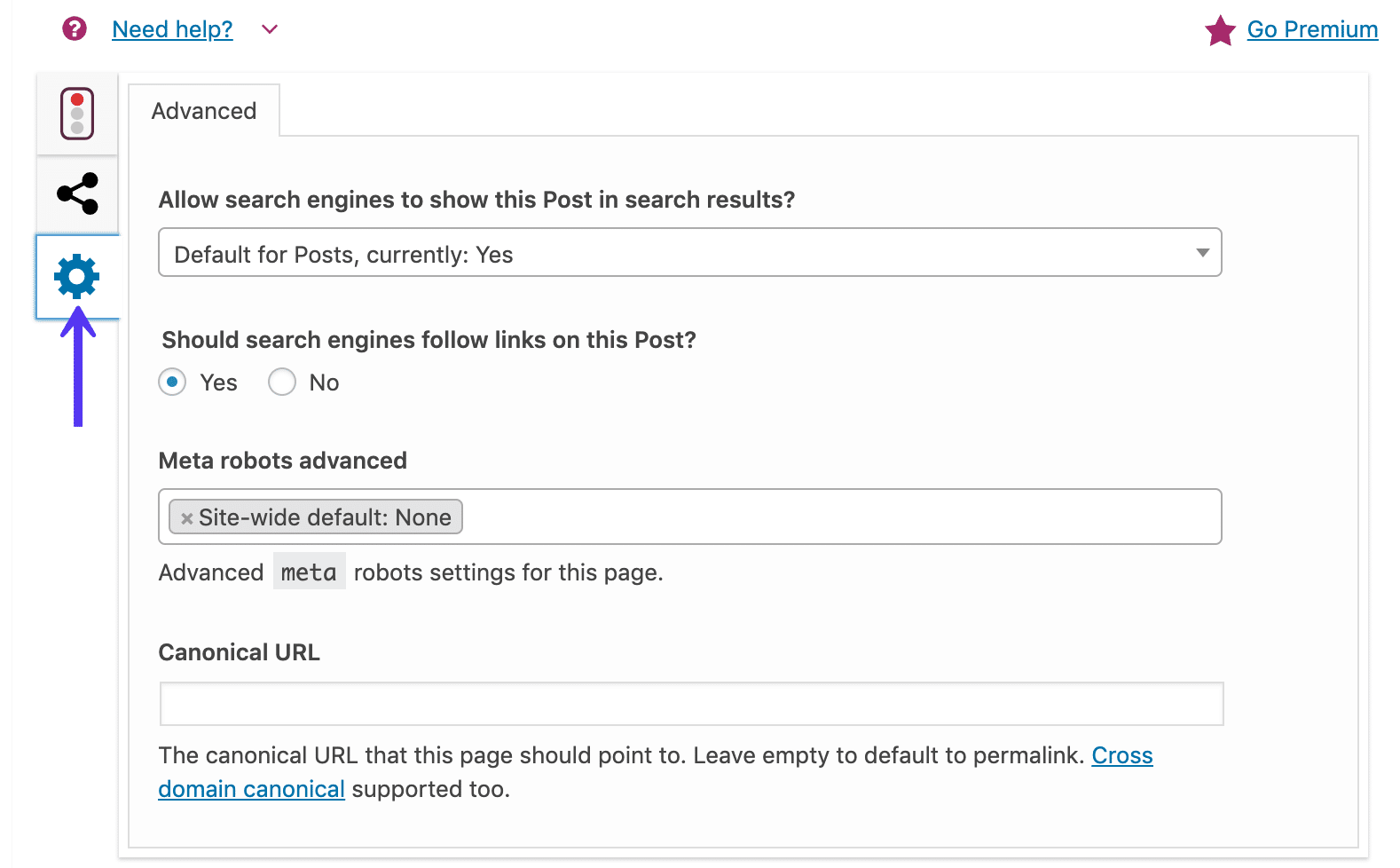
Exploring The Yoast SEO Dashboard
Now that you have Yoast SEO configured and understand the meta box, let's take a look at the dashboard.
On the main page of the dashboard (Under General), Yoast SEO will alert you to any potential SEO issues on your site.
For example, you can see that Yoast SEO doesn't like the way that our test site's tagline is still the default text:

Yoast will give you instructions for how to fix the issue. Or, you can always dismiss the notification if you don't want to address it.
General Tab
The General tab isn't very important, but it does let you:
- Access the configuration wizard
- Count the number of internal links in your post
Features Tab
The Features tab is a bit juicer than the previous tab. In this area, you can enable or disable specific features of Yoast SEO.
For example, if you don't find the Readability analysis in the Yoast SEO meta box helpful, you can turn it off here:
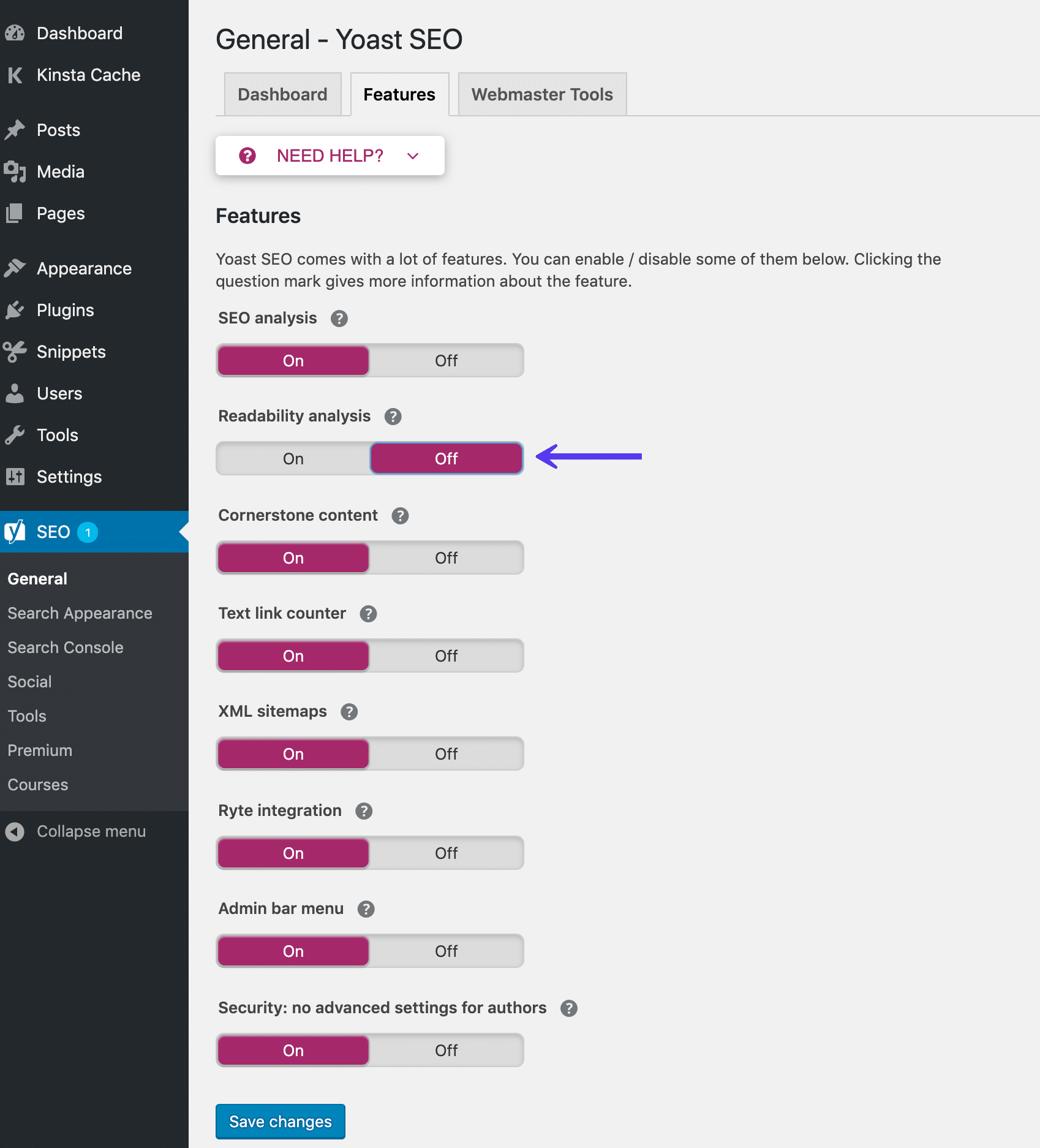
This is where you also can enable/disable security for authors. The advanced section of the Yoast SEO meta box allows a user to remove posts from the search results or change the canonical. These are things you might not want any author to do. That's why, by default, only editors and administrators can do this. Setting to "Off" allows all users to change these settings.
Looking for your XML sitemaps? Yoast SEO can help you automatically generate an XML sitemap that you can submit to search engines. More about WordPress sitemaps here.
In the newer versions of Yoast SEO, there is no longer a separate section for this. But you can still find a link to your XML sitemap by expanding the XML sitemaps tooltip and clicking on the "See the XML sitemap" link.
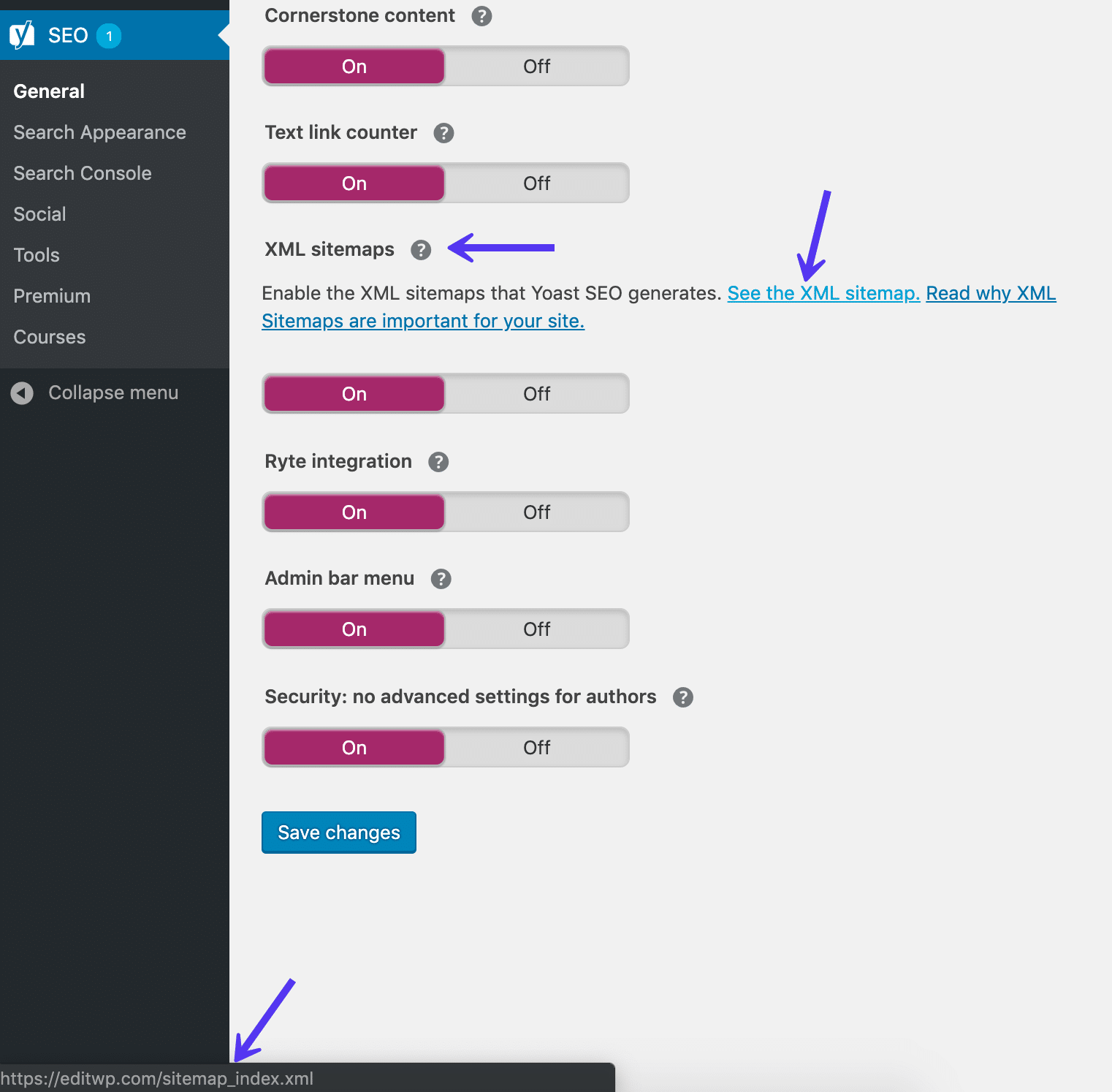
To exclude certain post types from your sitemap, this is now done from the Search Appearance area further below.
Webmaster tools Tab
In this tab, Yoast SEO can help you verify your site with various search engine's webmaster tools:
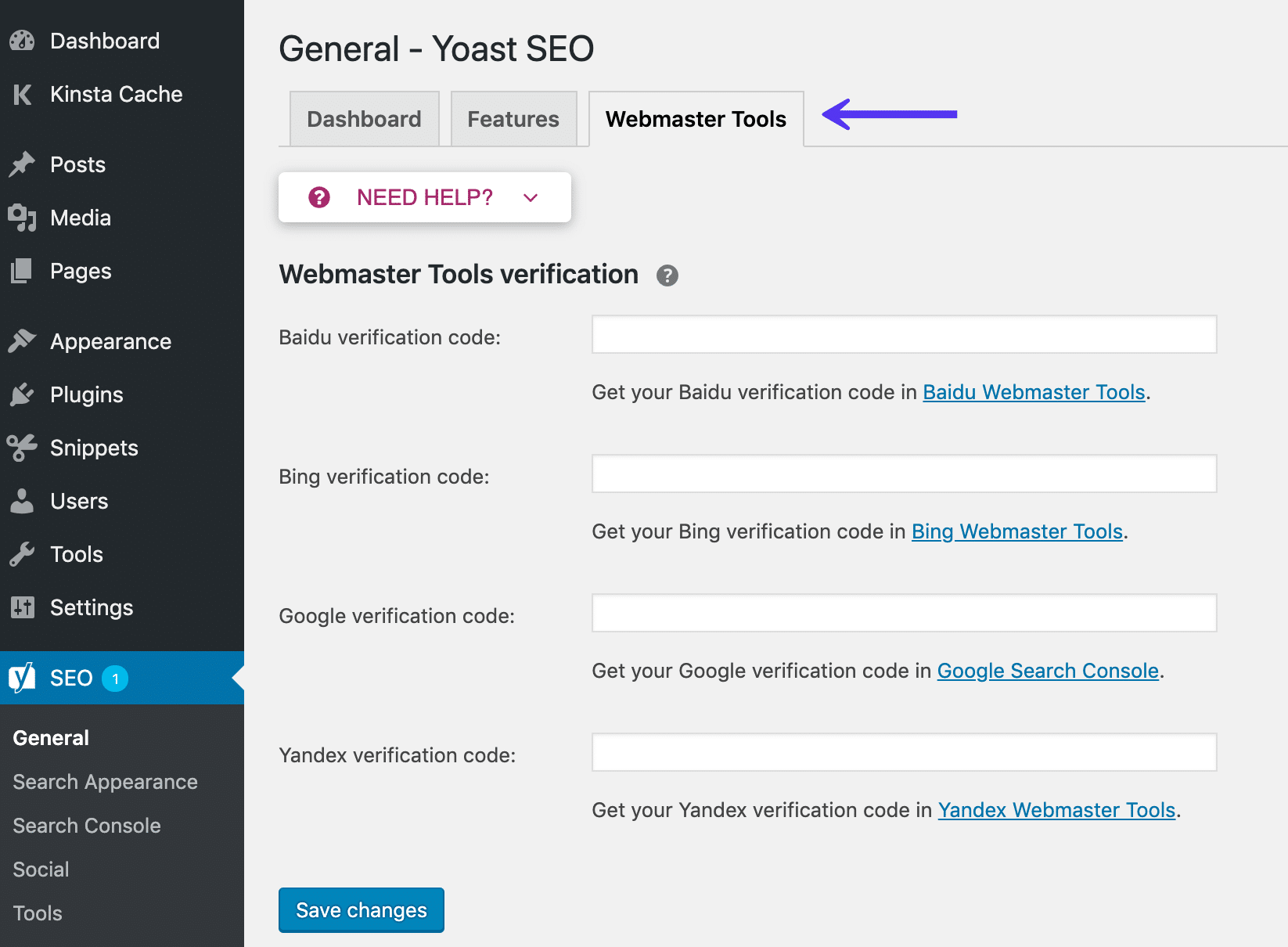
The More Advanced Guide To Yoast SEO
Congrats! At this point, you should have a pretty solid understanding of how to use Yoast SEO's core settings and features.
In this section, we're going to dig into some of the advanced settings that Yoast SEO keeps hidden away.
Search Appearance Options
Need to edit the knowledge graph & schema.org data? Perhaps you didn't use the configuration wizard. You can access this under the Search Appearance area. Click on the General tab and you can then edit your organization and or person data.

As of April 16, 2019, Yoast SEO version 11+ supports more structured data than ever before. It's added as JSON-LD to your site's code and they support Organization, Person, WebSite, WebPage, and article schema.
You can test your WordPress site using the Google Structured Data Testing Tool.
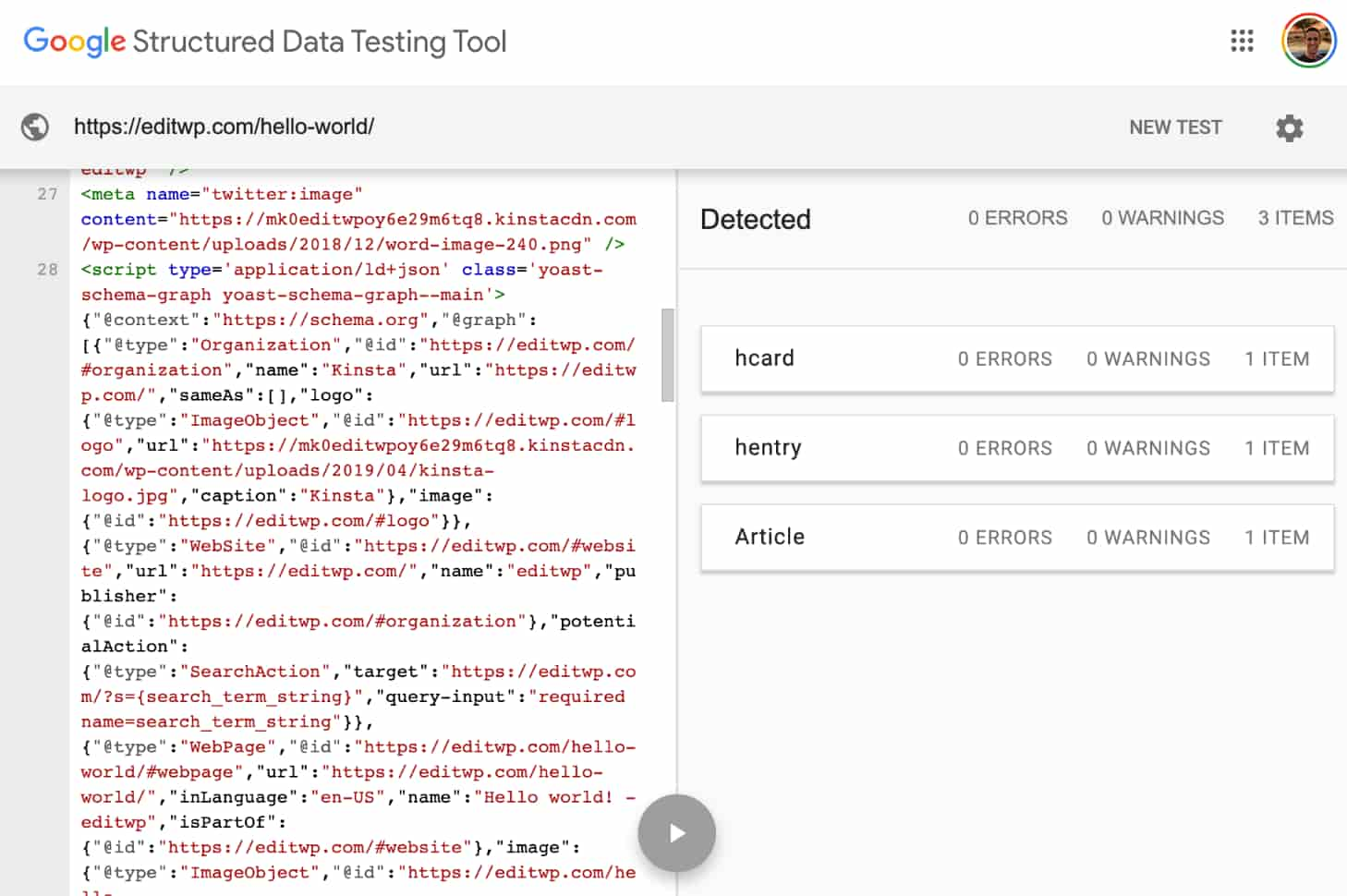
The Search Appearance area also provides some awesome ways to automate a lot of your on-page SEO.
Essentially, Yoast SEO lets you set templates for the SEO titles and meta descriptions for all of your:
- Posts
- Pages
- Custom post types
- Taxonomies
- Custom taxonomies
- Archive pages

What makes this so powerful is that you can use a wide range of variables to dynamically insert information including information contained in custom fields.
You can find a full list of these variables by clicking the Need Help? Button and choosing the Snippet variables tab:
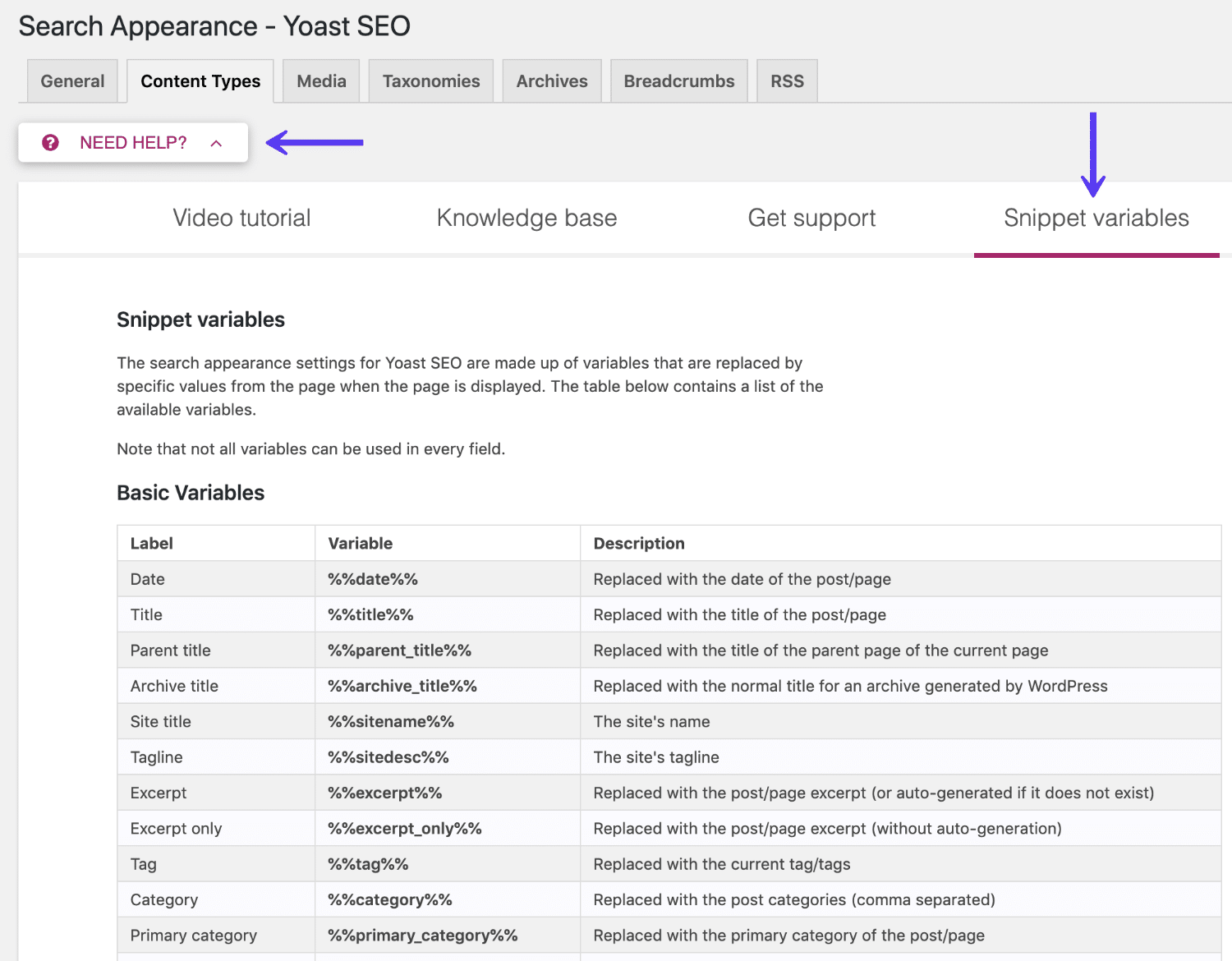
If you scroll down to the Advanced variables section, you can find some really neat time-saving hacks.
For example, let's say you run a coupon website and want to always make sure your post's title looks like:
Kinsta Coupon - Updated In February, 2018
Rather than manually editing the title each month to keep it up to date, you could just use the %%currentmonth%% and %%currentyear%% variables to have Yoast SEO automatically do it for you.
Other things that you can do in this area include:
- Control noindex tags for specific types of content. If you make something noindex, Google won't index that type of content in the search results. This is powerful so use it carefully. Only change the default settings if you know what you're doing and the implications.
- Choose whether or not to show a blog post's published date in the Google search results (Date in Snippet Preview). If you publish evergreen content, you should leave this turned off. But if you publish news or other time-specific content, it's a good option.
- Control whether or not the Yoast SEO meta box should appear for specific types of content.
Taxonomies Tab
The Taxonomies tab lets you do some cool things to clean up your site's permalinks.
One of the most useful features is the option to remove the category slug from your URLs:
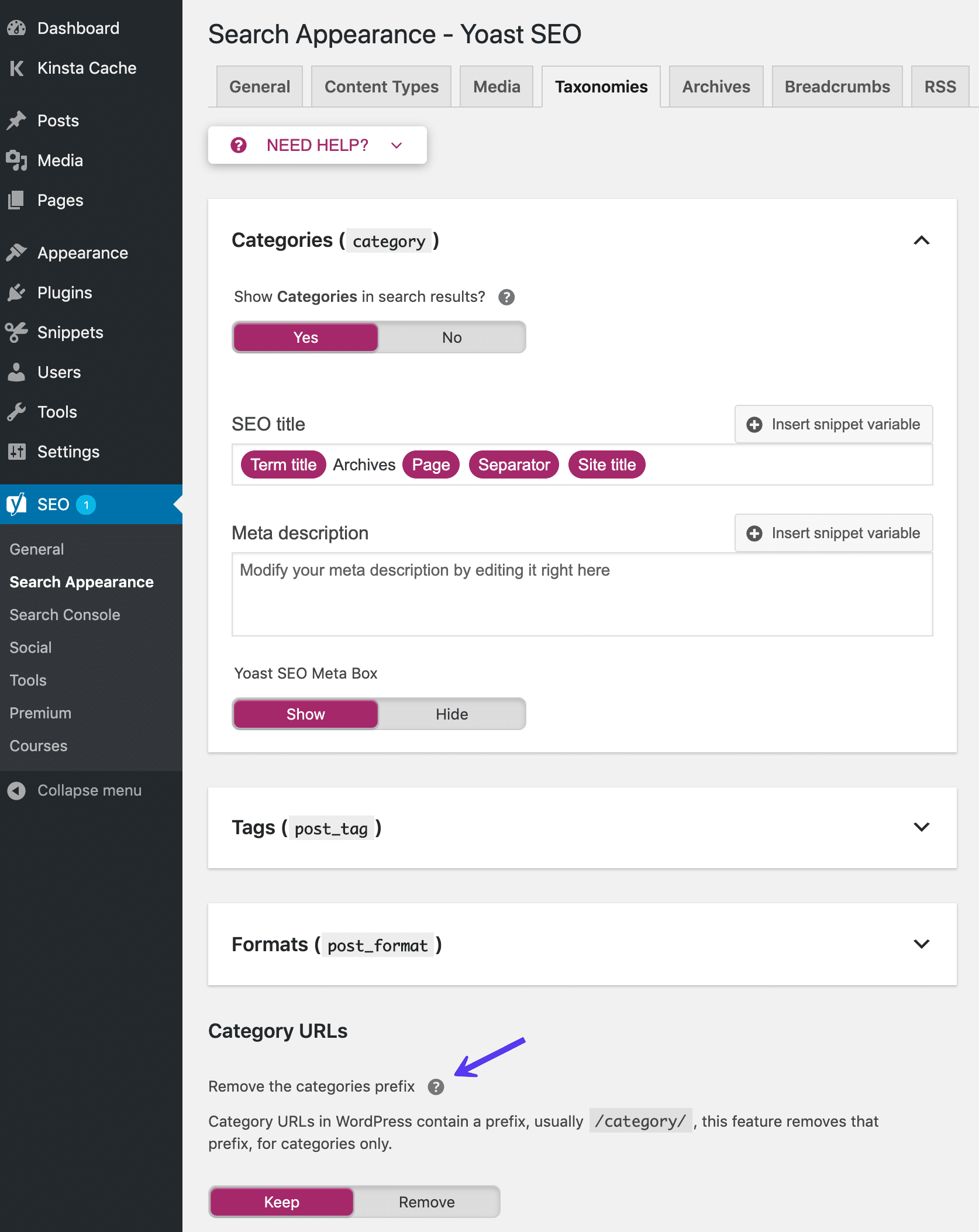
Breadcrumbs Tab
Breadcrumbs are a navigational feature that look something like this:

They're generally regarded as a positive for helping users navigate your site.
In this section, you can enable them via Yoast SEO. But, you'll also need to add a small code snippet to your theme in order to get the breadcrumb feature working:
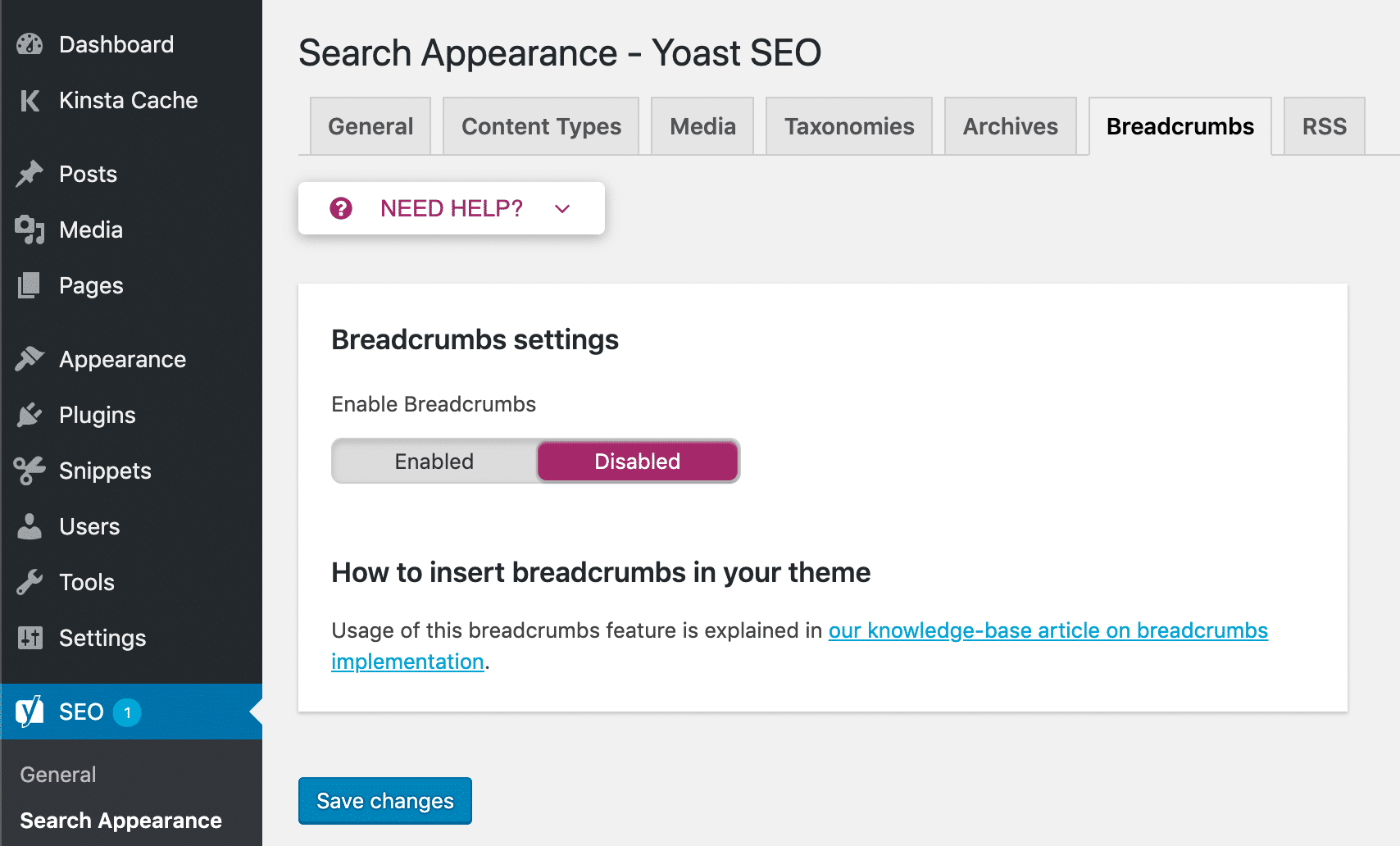
RSS Tab
Finally, the RSS tab lets you insert extra content before or after your post content in your RSS feed. You can also use some variables to dynamically insert information, like a link to your blog to ensure proper citation:
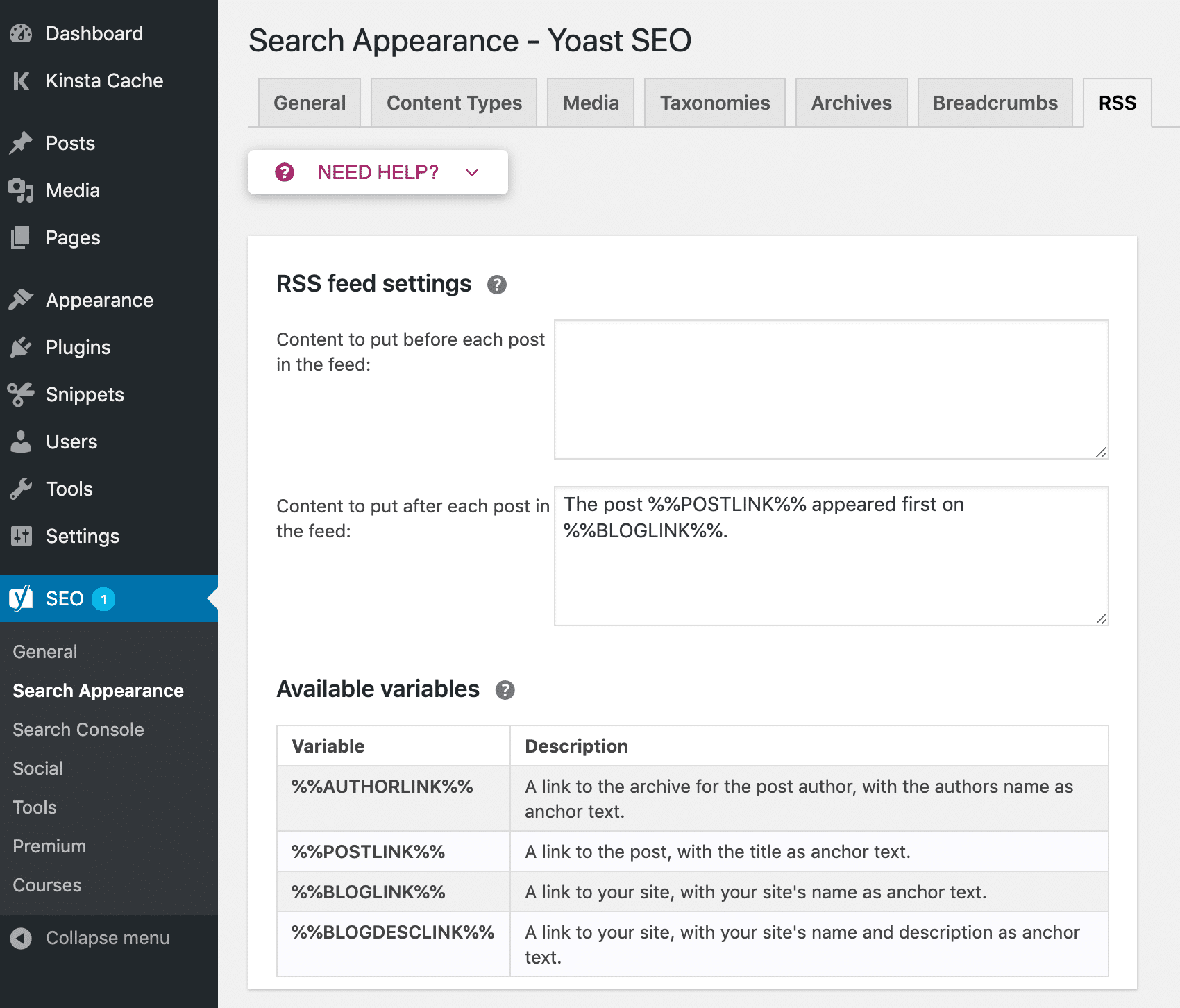
Social Options
In the Social area, you can configure more general settings for how your site interacts with various social networks.
Most of the time, you'll want to leave these as the defaults, though:
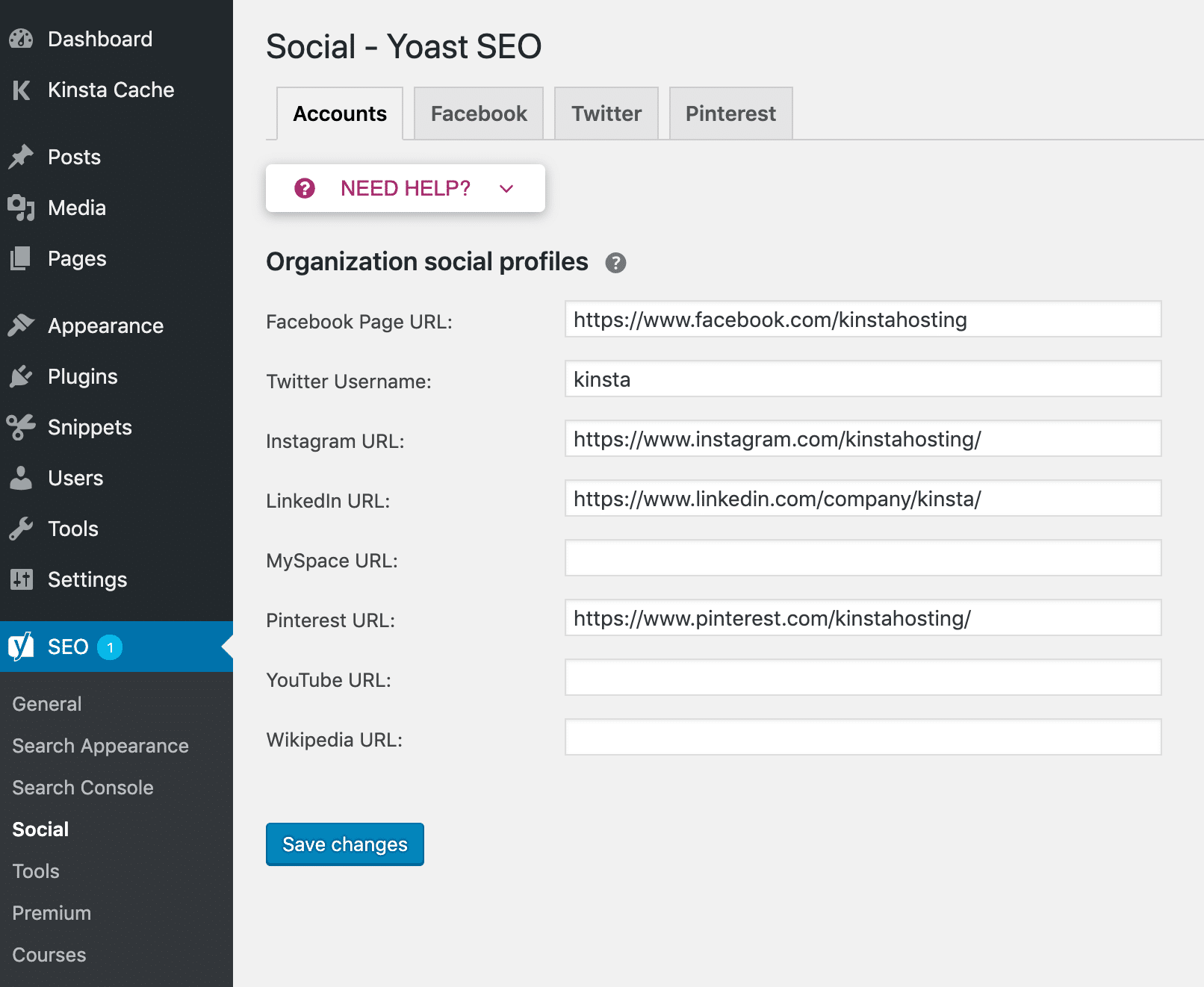
Tools Options
Finally, the Tools area lets you access various types of editors, as well as an option to import or export your Yoast SEO settings:
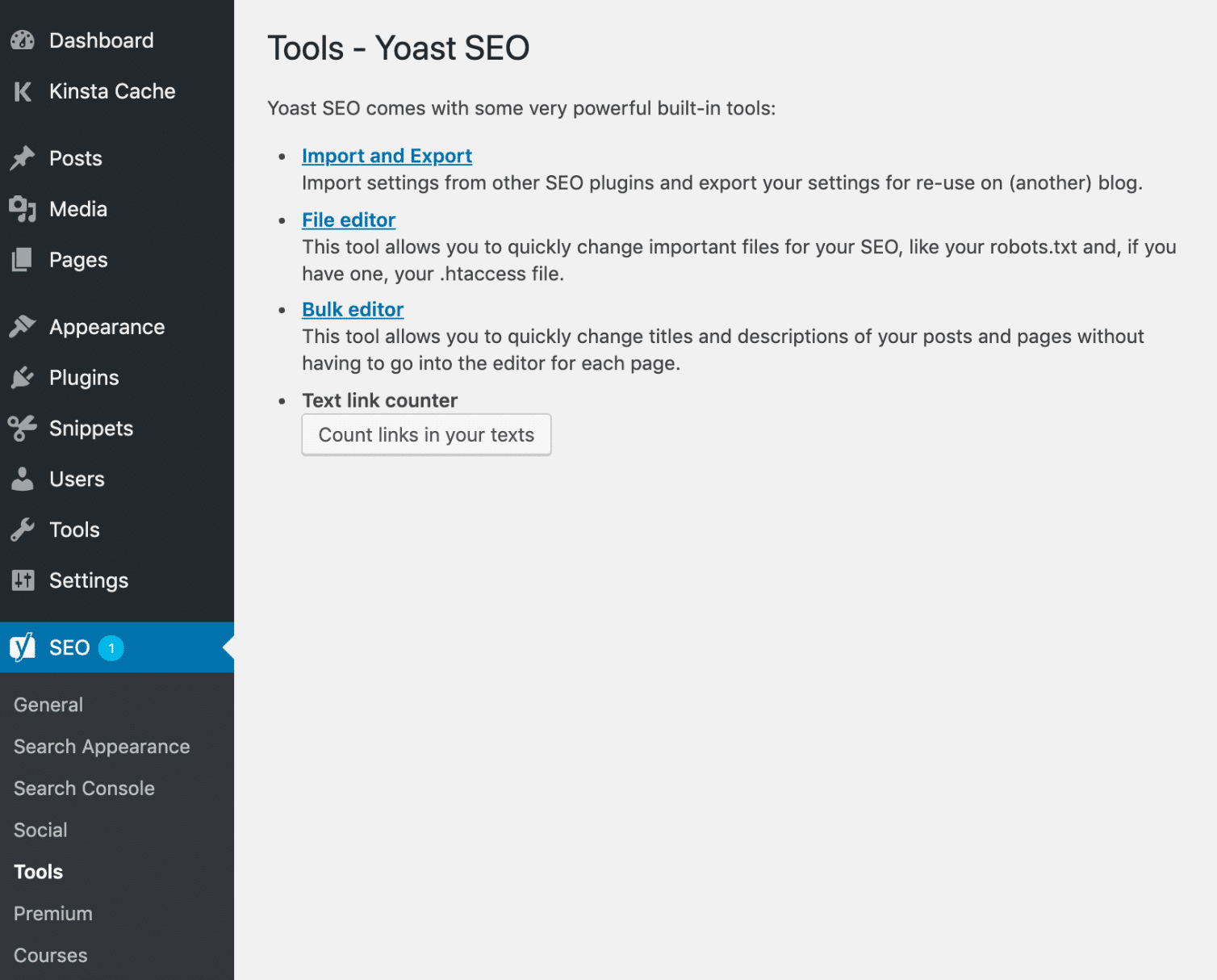
One helpful thing that you can do here is edit your WordPress site's robots.txt file right from your dashboard. There is no need to SFTP into your site.
If you click on the File editor option, Yoast SEO will help you create a robots.txt file (if you haven't already). And once you have the file, Yoast SEO will let you edit it right there in your dashboard:

If you don't see the File editor option, this means one of two things.
- Your
.htaccessfile or the folder in Nginx isn't writable on your web server. You can reach out to your hosting provider for assistance with this. - Your WordPress install has file editing disabled.
How to Use Yoast SEO in Your Everyday Website Life
As we hit the end of this guide, let's round up with a look at how you'll actually use Yoast SEO in your everyday WordPress life.
Most of Yoast SEO's options are "set it and forget". Once you get everything configured, the only area that you'll use on an everyday basis is the Yoast SEO meta box.
For every post, you should, at a minimum:
- Enter a focus keyphrase. You don't need to address every single suggestion from Yoast SEO, but trying to get a green light is usually a good goal.
- Configure the SEO Title and Meta Description. Even if you set up a good template, you'll still want to manually edit these for most posts to make them as optimized as possible.
Other things that you might want to address include:
- Readability
- Social settings, especially if you think a specific piece of content has a chance of doing well on social media
Any other questions about how to use Yoast SEO? Leave a comment and let's get your site ranking!
Want to learn more about how to drive traffic to your website with SEO?
Save time, costs and maximize site performance with:
- Instant help from WordPress hosting experts, 24/7.
- Cloudflare Enterprise integration.
- Global audience reach with 29 data centers worldwide.
- Optimization with our built-in Application Performance Monitoring.
All of that and much more, in one plan with no long-term contracts, assisted migrations, and a 30-day-money-back-guarantee. Check out our plans or talk to sales to find the plan that's right for you.
How To Install Seo Plugin In Wordpress
Source: https://kinsta.com/blog/yoast-seo/
Posted by: terrellfolody.blogspot.com

0 Response to "How To Install Seo Plugin In Wordpress"
Post a Comment